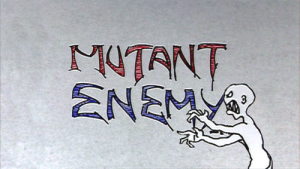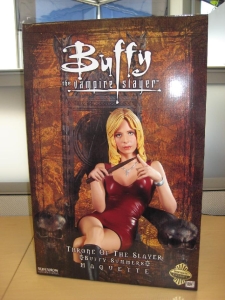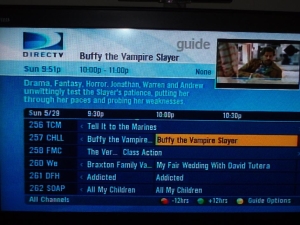 Buffy the Zombie Trademark Slayer
Buffy the Zombie Trademark Slayer
I recently finished an extremely important project: rewatching all 144 glorious episodes of the acclaimed late 90s/early 2000s TV show “Buffy the Vampire Slayer.” This got me thinking about how a company protects its trademarks when the main product (in this case, a TV show) is no longer being produced, and the related – and somewhat appropriate – topic of “zombie” trademarks. If you read the whole post, I’ll even tell you my three favorite episodes.
Buffy the Vampire Slayer started its life as a not-very-good 1992 movie from 20th Century Fox written by Joss Whedon and directed by Fran Kubel Kuzui. A few years later, the fledgling (and no longer in existence) WB Network decided to greenlight a spinoff TV show, with Whedon as Executive Producer and “show runner.” The show ran from 1997-2003 and was groundbreaking and generally amazing.
Flash forward 10 years to the present day. As I wrote in a blog post last year regarding the fate of the TWINKIES trademark:
Marks that are not used in commerce for several years (three years is the generally-accepted rule of thumb) are considered abandoned. When a mark retains some level of fame, but no individual entity has rights in it due to abandonment, it can become a “Zombie Trademark” – kept alive in the public’s imagination but not in the marketplace. In theory, another party (or parties, which is where it gets confusing and potentially litigious) could come along and lay claim to it.
Does this mean that anyone can come along and create a new Buffy TV show or related products without infringing on the legal rights of Fox, who are the owners of the Buffy empire? Not exactly.
Fox currently owns 7 U.S. trademark registrations for the name BUFFY THE VAMPIRE SLAYER, for the following goods or services:
- Metal key chains.
- Dolls; toy action figures and accessories.
- Pre-recorded [ video tapes, video cassettes, ] videodiscs featuring television programs [ ; decorative magnets; computer game cassettes and cartridges ].
- [ Bookmarks, trading cards; posters; personal diaries, journals; photo albums; wall calendars; postcards; paper knobs hangers; note pads; mounted and unmounted photographs; bookends; folders; notebooks, fictional novels; ] comic books.
- Compact discs and CD-ROMs featuring music and audio recordings related to television programs; [ mouse pads; computer and video software featuring television entertainment; computer and video game software; computer game CD- ROMs; video game CD- ROMs adapted for use with television receivers ].
- Entertainment services in the nature of a dramatic television series.
- [ pants; dresses; ] tank tops; sweatshirts [ ; skirts ].
What’s up with the brackets? Are they even still making computer game cassettes and cartridges? Thanks for asking. In order to maintain a trademark registration with the US Patent and Trademark Office (USPTO), you have to file certain forms between 5 and 6 years after the registration is issued, between 9 and 10 years after the registration is issued, and every 10 years thereafter. These forms require a statement and some sort of evidence that you are still using the mark in connection with the claimed goods/services in interstate commerce (meaning, more than one US state).
Let’s say you have a trademark registration for pencils and pens, but 5 years later, you are only making pens. You would then omit “pencils” from the maintenance filing. In the above examples, the items in brackets were omitted from these filings by Fox because, presumably, either the type of good doesn’t exist anymore (cassettes, more or less), or there is simply not a market for Buffy-branded mouse pads, so Fox decided not to continue producing and selling them.
As far as the other stuff, Fox apparently is still selling enough Buffy merchandise to justify these filings. For example, in connection with the the registration for “dolls,” Fox submitted as a specimen of use this photo of a sculpture of Buffy sitting on the “Throne of the Slayers” (whatever that is; I just watched 144 episodes and don’t remember anything about a throne, although maybe it appeared in one of the spinoff comics):

And really, that’s all you need to do: just show that you’re still using the mark in connection with the goods in interstate commerce. For better or worse, the USPTO isn’t terribly aggressive about policing these claims.
But what about the registration for “Entertainment services in the nature of a dramatic television series?” Are they still providing those services?
In 2011, when that registration came up for renewal, Fox submitted as a specimen of use the following photo of a DirectTV preview guide for a “Buffy” rerun:

The registration maintenance form was accepted. So all Fox needed to do to maintain their registration was to show that a TV provider was showing a rerun of an episode featuring Buffy battling the trio of supernerds, her arch nemesis..es.
Not all off-the-air TV shows have live trademark registrations for their titles, but Buffy is still popular enough to be worth the effort and filing fees. Fox continues to sell DVDs of the series and to license authorized products. And Joss Whedon himself continues to produce an outstanding series of comic books featuring the continuing adventures of the show’s characters.
While Buffy may continue to face a variety of supernatural threats, zombie trademarks are not one of them. And don’t worry too much about Joss Whedon. Last year he directed The Avengers, the 3rd highest grossing movie of all time. He’s hard at work on the sequel.
And now…the 3 best episodes of Buffy the Vampire Slayer, in sequential order, are:

